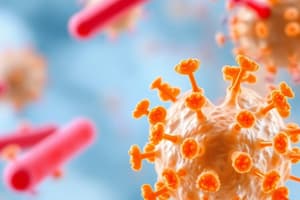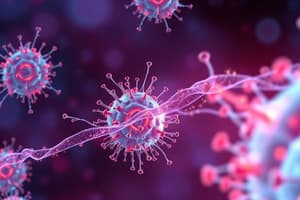Podcast
Questions and Answers
What are the key domains present in the TCR alpha chain?
What are the key domains present in the TCR alpha chain?
- Vβ, Cβ, Dβ
- Vγ, Jγ, Cγ
- Vδ, Jδ, Cδ
- Vα, Jα, Cα (correct)
Which enzymes are involved in the recombination of TCR gene segments?
Which enzymes are involved in the recombination of TCR gene segments?
- RAG-1, PCR, TdT
- RAG-2, RNA polymerase, TdT
- CD4, CD8, TdT
- RAG-1, RAG-2, TdT (correct)
What happens to the majority of immature T cells in the thymus?
What happens to the majority of immature T cells in the thymus?
- They migrate back to the bone marrow.
- They are modified to become memory T cells.
- They die by apoptosis and are eliminated. (correct)
- They undergo rapid cell division.
During which phase do T cell precursors express neither CD4 nor CD8 receptors?
During which phase do T cell precursors express neither CD4 nor CD8 receptors?
What is a key characteristic of gamma-delta T cells?
What is a key characteristic of gamma-delta T cells?
What forms after the successful association of the beta chain with a pre-TCR alpha chain?
What forms after the successful association of the beta chain with a pre-TCR alpha chain?
What is the role of macrophages during T cell development in the thymus?
What is the role of macrophages during T cell development in the thymus?
What is the main reason the T cell development process is considered wasteful?
What is the main reason the T cell development process is considered wasteful?
What percentage of double-positive thymocytes graduate to become naïve T-cells?
What percentage of double-positive thymocytes graduate to become naïve T-cells?
Where do single positive T-cells express homing molecules for trafficking?
Where do single positive T-cells express homing molecules for trafficking?
Which of the following locations is specifically mentioned as a site for B-cell maturation in certain species?
Which of the following locations is specifically mentioned as a site for B-cell maturation in certain species?
Which component is NOT involved in the B Cell Receptor structure?
Which component is NOT involved in the B Cell Receptor structure?
What allows naïve T-cells to migrate to peripheral sites after recognizing their antigen?
What allows naïve T-cells to migrate to peripheral sites after recognizing their antigen?
What is one major characteristic of B-cell maturation compared to T-cell development?
What is one major characteristic of B-cell maturation compared to T-cell development?
What is the primary source of B lymphocytes?
What is the primary source of B lymphocytes?
Which organ is specifically associated with the final stages of B-cell maturation in ruminants?
Which organ is specifically associated with the final stages of B-cell maturation in ruminants?
What is the outcome for double positive cells during positive selection in the thymus?
What is the outcome for double positive cells during positive selection in the thymus?
What must an immature T cell do to successfully pass positive selection?
What must an immature T cell do to successfully pass positive selection?
During negative selection, what type of cells do immature T cells encounter?
During negative selection, what type of cells do immature T cells encounter?
What is the primary goal of negative selection in the thymus?
What is the primary goal of negative selection in the thymus?
What happens to T cells that produce a TCR with no or low affinity for peptide-MHC during positive selection?
What happens to T cells that produce a TCR with no or low affinity for peptide-MHC during positive selection?
Which of the following is important for the positive selection of T cells?
Which of the following is important for the positive selection of T cells?
Which cells display a wide range of normal tissue antigens during T cell development?
Which cells display a wide range of normal tissue antigens during T cell development?
What role does the AIRE gene play in T cell development?
What role does the AIRE gene play in T cell development?
Which enzyme complex is responsible for the recombination of V, D, and J regions to form B cell receptors?
Which enzyme complex is responsible for the recombination of V, D, and J regions to form B cell receptors?
What initiates the rearrangement process of B cell receptors?
What initiates the rearrangement process of B cell receptors?
What process allows B cells to express different constant regions such as IgG, IgE, and IgA?
What process allows B cells to express different constant regions such as IgG, IgE, and IgA?
Which type of chains are involved in the light chain genes of immunoglobulins?
Which type of chains are involved in the light chain genes of immunoglobulins?
During which stage do B cells first express the μ heavy chain?
During which stage do B cells first express the μ heavy chain?
What occurs during alternative junctional recombination in B cells?
What occurs during alternative junctional recombination in B cells?
What type of genetic change does somatic mutation describe?
What type of genetic change does somatic mutation describe?
Which immunoglobulin heavy chain is expressed first according to the gene arrangement?
Which immunoglobulin heavy chain is expressed first according to the gene arrangement?
What occurs to BCRs that bind to self-antigens during B cell development?
What occurs to BCRs that bind to self-antigens during B cell development?
What is the process called when a B cell undergoes further gene rearrangements to express an edited BCR?
What is the process called when a B cell undergoes further gene rearrangements to express an edited BCR?
Which type of antibodies are lacking in animals affected by SCID?
Which type of antibodies are lacking in animals affected by SCID?
What treatment approach has been researched for SCID in dogs?
What treatment approach has been researched for SCID in dogs?
Which breed of dog is NOT mentioned as being affected by SCID?
Which breed of dog is NOT mentioned as being affected by SCID?
What does the co-expression of IgM and IgD on naïve B lymphocytes signify?
What does the co-expression of IgM and IgD on naïve B lymphocytes signify?
What mutation is associated with SCID in Jack Russell terriers?
What mutation is associated with SCID in Jack Russell terriers?
What is a clinical consequence of SCID in affected animals?
What is a clinical consequence of SCID in affected animals?
Flashcards are hidden until you start studying
Study Notes
### TCR Structure
- T cell receptors (TCR) have alpha and beta chains.
- Alpha chain has a variable domain (Vα), a joining region (Jα), and a constant domain (Cα).
- Beta chain has Vβ, Cβ, Jβ, and diversity region (Dβ).
- There are multiple genes encoding Vα, Jα, Vβ, and Jβ regions.
- There's a single constant region gene for the Alpha chain (Cα).
- TCR α, β, γ, and δ chains are assembled by mixing and matching gene segments.
- Gamma (γ) and delta (δ) chains may form γδ T cells involved in innate and adaptive immunity.
T Cell Development
- T cell development occurs in the thymus.
- Thymocyte progenitors originate in bone marrow and migrate to the thymus.
- Double-negative phase: Progenitors initially lack CD4 and CD8 receptors.
- Recombination: RAG-1, RAG-2, and TdT facilitate recombination of TCR gene segments, forming V(D)J regions.
- Pre-TCR formed by β chain and pre-Tα chain.
- Double-positive phase: Functional pre-TCR leads to cell proliferation and CD4/CD8 co-expression.
- Alpha chain rearrangement: α chain complexes with β chain and CD3 to form the complete TCR.
T Cell Selection
- Positive selection occurs in the thymus cortex.
- Only 5% of double-positive cells survive.
- Cells acquire CD4 or CD8 based on their specificity for MHC I or II, respectively.
- TCR must interact with MHC-peptide complex, but with moderate affinity.
- Cells with no or low affinity die by neglect.
- Negative selection occurs in the thymus medulla.
- Tests whether TCRs recognize self-antigens with high affinity.
- Cells with high affinity for self-antigens undergo apoptosis.
- Only 2% of double-positive thymocytes become single-positive (CD4 or CD8) naïve T cells.
Naïve T Cells
- Naïve T cells leave the thymus and circulate.
- They express homing molecules to traffic through lymph nodes via high endothelial venules (HEVs).
- Activation occurs upon antigen recognition.
B Cell Development
- B cells arise from bone marrow stem cells.
- Maturation involves interactions with stromal cells.
- Maturation occurs in bone marrow and possibly extramedullary locations like ileal Peyer's patches (ruminants) or bursa of Fabricius (birds).
- B cell receptor (BCR) includes Igα and Igβ signal transducing molecules.
- BCR diversity achieved by recombining variable (V), diversity (D), and joining (J) regions.
BCR Diversity
- V(D)J recombinase complex, including RAG-1 and RAG-2, facilitates recombination.
- Light chains can be either kappa (Cκ) or lambda (Cλ), involving V and J segments (no D region).
- Heavy chain rearrangement first, followed by light chain rearrangement if successful.
- Heavy chain constant region genes arranged in the order Cμ, Cδ, Cγ, Cε, and Cα, with IgM being the first expressed.
B Cell Activation and Class Switching
- Activated mature B cells undergo class switching, expressing different constant regions (IgM to IgG, IgE, or IgA).
- Junctional alternatives and somatic mutations further increase BCR diversity.
B Cell Maturation Stages
- Pre-B cells produce μ heavy chain in the cytoplasm.
- Immature B cells display complete IgM monomers on their surface.
- Negative selection eliminates self-reactive BCRs by apoptosis or receptor editing.
- Naïve B cells co-express surface IgM and IgD, joining the recirculating B-cell pool.
Severe Combined Immunodeficiency (SCID)
- SCID affects dogs and horses, as well as humans.
- Canine SCID involves mutations in the DNA protein kinase gene, affecting VDJ recombination in TCR and BCR formation.
- Results in lack of adaptive immunity, bacterial/viral infections, lymphopenia, and hypoplasia of lymphoid tissue.
- SCID is treated by bone marrow transplantation, stem cell transplantation, or gene therapy.
- Arab horses also exhibit SCID due to a deletion in the DNA-dependent protein kinase involved in VDJ recombination.
Studying That Suits You
Use AI to generate personalized quizzes and flashcards to suit your learning preferences.




